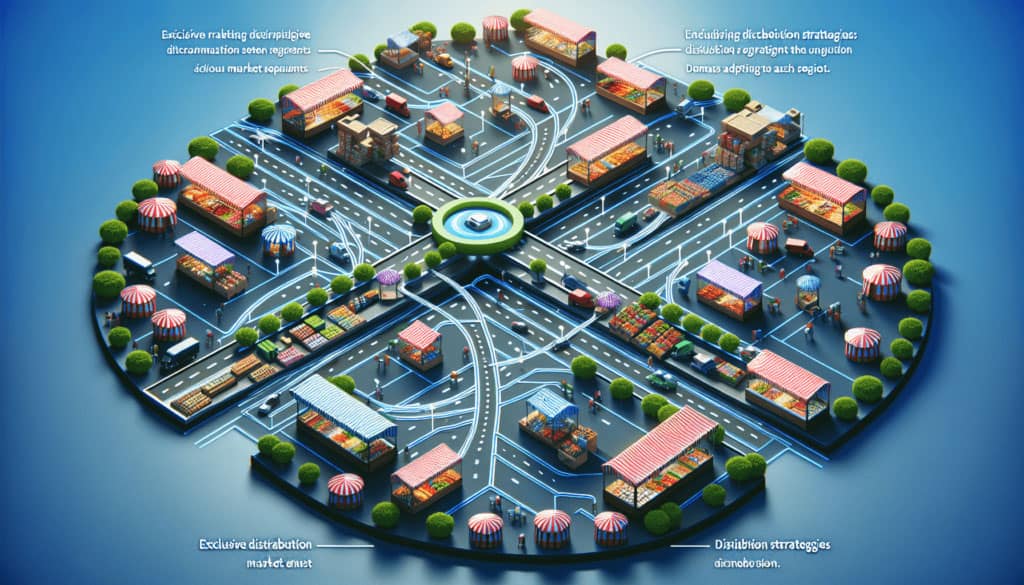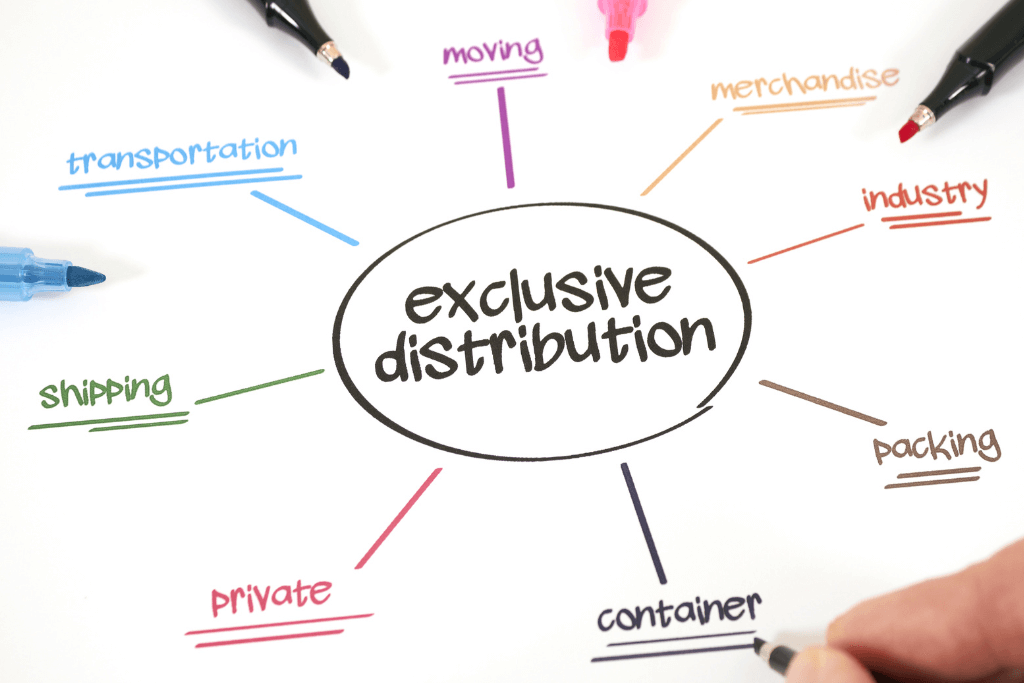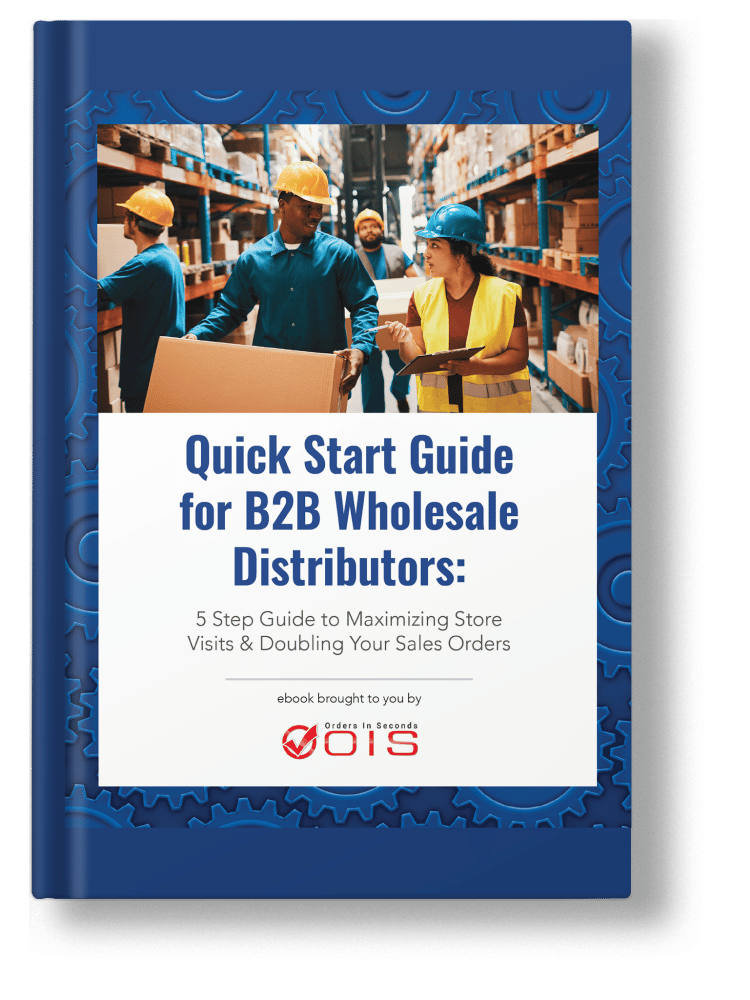In the dynamic world of business, controlling the way your product reaches the customer is an art. Exclusive distribution is one such art, enabling manufacturers to control their product’s journey from the factory to the customer’s hands. But how does it work, and what makes it so unique? Let’s find out.
3 Key Strategies for Exclusive Distribution
- Exclusive distribution is a strategic partnership where a single distributor is granted the rights to sell a product in a specific market, benefiting manufacturers with consistent branding, controlled pricing, and reduced competition.
- A comprehensive and legally compliant exclusive distribution agreement is essential to define the terms of partnership, pricing, quality, marketing, and territorial scope to ensure mutual benefits and avoid legal disputes.
- Selecting the right exclusive distributors involves assessing potential partners for financial stability, market understanding, reputation, and alignment with company goals to build successful, enduring partnerships.
Table of Contents
- Decoding Exclusive Distribution Strategy
- Crafting Your Exclusive Distribution Agreement
- Identifying and Selecting Exclusive Distributors
- Leveraging Exclusive Distribution in Different Market Segments
- Exclusive Distribution vs. Other Distribution Models
- Exclusive Distribution's Role in Brand and Product Lifecycle
- Case Studies: Success Stories of Exclusive Distribution
- Best Practices for Managing an Exclusive Distribution Network
- Summary
- Frequently Asked Questions
- Improve Your Wholesale Business with Orders in Seconds
Decoding Exclusive Distribution Strategy

Exclusive distribution is an effective product distribution strategy that manufacturers use to control how their products or services reach consumers. In essence, it involves partnering with a single distributor who has the exclusive rights to sell the product in a certain market or region. This strategy is commonly used by companies with high quality products or services that require specialized knowledge to sell, such as in the industrial machinery segment. Some key benefits of exclusive distribution include:
- Ensuring consistent branding and messaging
- Maintaining control over pricing and distribution
- Building strong relationships with distributors
- Reducing competition and protecting market share
Overall, exclusive distribution helps manufacturers maintain a strong presence in the market and ensure the success of their product distribution or services, offering exclusive distribution advantages. By choosing to utilize exclusive distribution, manufacturers can further strengthen their market position.
The exclusive distributor becomes a significant partner, dedicated to selling the manufacturer’s products with greater intensity than competitors. This reinforces the product’s exclusivity and differentiation in the market.
The Essence of Exclusive Distribution
Fundamentally, exclusive distribution is a contractual agreement between a manufacturer and a distributor, where the distributor gets the exclusive rights to sell the manufacturer’s products in a particular territory. This strategy is often seen in the automobile industry, where each distributor is singularly authorized to sell a specific make of car within a designated territory.
At its core, exclusive distribution establishes a binding agreement between a manufacturer and a distributor, granting the latter the sole authority to market and sell the manufacturer’s offerings within a defined geographical area. A prime example of this strategy can be observed in the automotive sector, where dealerships are uniquely franchised to sell particular car brands within specific territories.
For manufacturers considering or managing exclusive distribution networks, having a detailed list of retail stores within potential or existing territories can provide invaluable market intelligence. This allows for a better understanding of the retail landscape and helps in evaluating the potential reach and effectiveness of exclusive agreements.
Mapping the Benefits

Exclusive distribution has unique strategic benefits. It allows manufacturers to maintain better control over their brand image and facilitates the implementation of premium pricing strategies. Selecting exclusive distributors with the financial capability to stock substantial quantities of the product, manufacturers can ensure product availability and mitigate financial risks associated with inventory management.
Navigating the Challenges
While exclusive distribution has multiple advantages, it also has associated challenges. Companies can face difficulties when the product experiences widespread demand, uncertainties in the supply chain, or when pricing changes impact the perceived exclusivity.
To lessen these risks, manufacturers should carefully evaluate channel members, negotiate distribution agreements cautiously, and be prudent when granting unconditional exclusivity.
Crafting Your Exclusive Distribution Agreement
An exclusive distribution agreement lays the foundation for the relationship between the manufacturer and the distributor. It outlines the following terms and conditions that both parties must adhere to:
- Pricing and payment terms
- Quality standards and warranties
- Marketing and promotional activities
- Scope of territory and exclusivity
By having a clear and comprehensive agreement in place, both the manufacturer and the distributor can ensure a successful and mutually beneficial partnership.
Considering the legal aspects is vital to ensure the agreement is valid and compliant with the relevant laws.
Key Elements of an Agreement
A comprehensive exclusive distribution agreement is necessary, encompassing all the terms that are mutually agreed upon by both parties in an exclusive agreement. This includes the financial terms, performance obligations of the distributor, and also the terms of termination. These elements ensure that both parties are committed to meeting their obligations and working towards a common goal, as outlined in their exclusive distribution agreements.
When creating an exclusive distribution agreement, it’s important to ensure that it complies with all relevant laws and regulations. This includes:
- Meeting the legal obligations and implications of antitrust laws
- Incorporating necessary clauses to guarantee legal compliance
- Structuring the termination clause to ensure legal validity
A legally sound agreement is vital to avoid potential conflicts and legal disputes.
Identifying and Selecting Exclusive Distributors
Choosing the appropriate exclusive distributor is a significant step in the successful implementation of an exclusive distribution strategy. Companies need to assess potential distributors based on factors such as:
- Financial stability
- Understanding of the product’s features and benefits
- Market alignment
- Distribution channels
Geographical location also plays a vital role as it plays a significant role in the success of the distribution strategy.
Criteria for Selection
The selection of a suitable distributor involves considering the following factors:
- Qualifications
- Financial stability
- Ability to meet performance obligations
- Outstanding reputation
- Robust partnerships
- Enthusiasm
- Dedication
- Market acumen
Companies should look for other distributors that possess these qualities.
Avoiding common mistakes like lack of comprehension of the distribution channel and sales representatives lacking in information and resources can save companies from potential pitfalls.
Talking about avoiding mistakes, it’s crucial to be well-informed about common errors in the entire wholesale distribution landscape, not just in the exclusive distribution realm. Explore further in our Free eBook ‘Avoid the Top 5 Mistakes Wholesale Distributors Make.’

Avoid the Top 5 Mistakes Wholesale Distributors Make
Are you making one of the top 5 mistakes that plague wholesale
distributors? Download our free eBook to find out. We’ve also included tips and guidance to help you save time and avoid costly mistakes.
Establishing a robust relationship with an exclusive distributor involves:
- Continuous communication
- Providing incentives and rewards
- Collaborating and co-creating
- Addressing any issues promptly
This not only ensures a smooth working relationship but also leads to a successful and long-lasting partnership.
Leveraging Exclusive Distribution in Different Market Segments

Exclusive distribution is not a universal strategy. It needs to be tailored to suit different market segments, aligning with the unique demands and preferences of each segment. Understanding the traits of each market segment, companies can effectively customize their exclusive distribution strategies, ensuring the product reaches the right consumers.
Tailoring to Consumer Demand
Adjusting to consumer demand is an essential element of any successful exclusive distribution strategy. It involves:
- Understanding the needs and desires of the target audience
- Enabling businesses to align their product strategies
- Customizing their exclusive distribution approaches accordingly.
Changes in consumer behavior necessitate adjustments in the distribution channels to align with consumer preferences and demands.
Expanding into New Markets
Exclusive distribution can be an influential strategy for penetrating new markets. By granting exclusive rights to sell a product to a single retailer in a specific market, companies can increase their revenue margins, enhance product value, and improve brand loyalty. However, it’s also important to adjust the product distribution strategies to meet the distinct requirements and preferences of each specific consumer group.

Exclusive distribution represents one among numerous distribution models available to companies. Other models, such as selective distribution and intensive distribution, offer their own sets of advantages and challenges. While exclusive distribution offers the highest level of brand perception control, it also places a higher burden on retailer selection through selective distribution.
On the other hand, intensive distribution amplifies complexity and costs by involving multiple distribution partners.
When to Choose Exclusive Over Others
The choice between exclusive distribution and other models hinges on a variety of factors, including:
- The potential for higher profit margins
- Level of control over the distribution channel
- Characteristics of the product and market
- Competitive factors
Exclusive distribution is often chosen when a company’s objective is to uphold stringent quality standards, exert control over product sales, and guarantee a uniform and high-quality brand experience for customers.
Balancing Exclusivity with Reach
While exclusive distribution can enhance a product’s exclusivity and stimulate demand, companies also need to consider the potential impact on their market reach. Achieving a balanced approach between exclusivity and market reach is significant to ensure that a product is delivered to the intended specific market segment or demographic, without compromising the prestige or distinctiveness of the brand.
Exclusive distribution has a prominent role at various stages of a brand or product’s lifecycle. From the initial launch phase, where it simplifies the firm’s focus and creates a perception of exclusivity, to the growth stage, where it fosters long-term growth by establishing a robust retail network, exclusive distribution can be a powerful tool for brand and product success.
Impact on Launch Phase
During the preliminary launch phase, exclusive distribution can assist streamline the product launch process and establish a new product in the market. By offering distributors higher profit margins and enabling greater control over the product’s sales, exclusive distribution ensures the preservation of quality and a consistent brand image, which are essential for creating an initial market presence for the new product.
Sustaining Growth with Exclusivity
As a brand or product evolves, maintaining growth becomes a principal challenge. Exclusive distribution can play a crucial role in this phase by:
- fostering a perception of luxury and distinctiveness
- leading to increased profit margins
- enabling companies to maintain strict oversight of their products through authorized resellers
- allowing them to replicate successes during the product’s maturity phase
- adapting distribution methods to prolong the product’s life.
Grasping the concept of exclusive distribution is significant, but real-life examples can truly bring the concept to life. Companies like Rolex, Gucci, and Lamborghini have effectively utilized exclusive distribution to uphold their brand image and control their product’s journey from the factory to the customer’s hands.
Luxury Brands Leading with Exclusivity

Luxury brands such as Rolex and Lamborghini have utilized exclusive distribution to maintain their premium image. They restrict the sale of their products to a chosen group of authorized dealers and boutiques, ensuring that their luxury products are not accessible through mainstream retail channels.
This fosters an impression of exclusivity and luxury, which is crucial to the market positioning and brand equity of such high-end brands.
Innovators in Exclusive Distribution
Innovation and adaptation are essential for maintaining relevance in the dynamic world of business. Companies that have pioneered new approaches to exclusive distribution have seen significant success. By leveraging authorized resellers and forming exclusive deals with retailers, they have been able to uphold product control, minimize market competition, and ensure the product reaches the right consumers.
Effective management of an exclusive distribution network demands consistent monitoring and evaluation. Companies need to:
- Evaluate market and customer needs
- Choose appropriate distribution channels
- Offer continuous training and support to distributors
- Establish efficient communication with retail partners
- Consistently assess performance to inform decisions.
Monitoring Sales and Market Trends
Close monitoring of sales performance and market trends is vital to inform your exclusive distribution strategy. Tracking key metrics such as inventory turnover rates, sales velocity, and overall product performance can reveal trends and identify areas for improvement.
Embracing and investing in technological advancements enables businesses to more effectively respond to market shifts and refine their distribution strategies.
If best practices for sales are of interest to you, consider exploring our free eBook ‘Double Your Sales Orders in 5 Steps’ for actionable insights on maximizing your revenue potential.

Double Your Sales Orders in 5 Steps
This exclusive eBook is packed with real-world, data-driven concepts that can help maximize your store visits and double your sales. Get it for FREE – Today!
Continuous Improvement and Adaptation
In the ever-changing business environment, adaptability is the only constant. Companies need to be ready to adapt their distribution strategies as market conditions change. Regular evaluation and adjustments are key to ensuring that your exclusive distribution approach continues to deliver the desired results.
Exclusive distribution is a potent strategy that allows manufacturers to control their product’s journey from the factory to the customer’s hands. By partnering with a single distributor and granting them exclusive rights to sell the product, companies can uphold their brand image, maintain quality standards, and potentially increase profit margins. However, it also presents its own set of challenges and complexities, requiring careful planning and execution. Despite these challenges, when implemented correctly, exclusive distribution can play a crucial role in a brand’s success, from the initial launch phase to long-term growth and expansion.
Frequently Asked Questions
An example of an exclusive type of distribution is when a popular celebrity releases a new podcast exclusively on a paid platform like Spotify Premium. This ensures that the content is only available through the selected distribution partner.
What are examples of exclusive distribution companies?
Examples of companies that use exclusive distribution include Apple for its high-priced and luxury products, as well as companies like Lamborghini, BMW, Rolex, and Mercedes. These companies appoint only a few distributors to cover a specific region, maintaining exclusivity in their distribution agreements.
What is an example of selective distribution and exclusive distribution?
An example of selective distribution is when a company signs an exclusive deal with a network like ABC, CBS, or Showtime to initially air a TV series only on that network, and later selectively distributes reruns to other networks.
What is exclusive distribution?
Exclusive distribution is a strategy where a single distributor is given exclusive rights to sell a product in a specific market or region. It involves a partnership between the manufacturer and the distributor to limit competition.
What are the advantages of exclusive distribution?
Exclusive distribution provides strategic advantages including better brand control, the ability to implement premium pricing, and improved customer experience.
Improve Your Wholesale Business with Orders in Seconds
As we explore the dynamics of wholesale distribution, we’d like to introduce Orders in Seconds, a trusted partner for over 17 years, specializing in empowering small to mid-size wholesale distributors. Our OIS Pro App, an advanced order-taking solution, ensures precision, and our OIS eCommerce App provides a 24/7 sales channel for unmatched scalability.
OIS is committed to transforming your operations, minimizing errors, and seizing opportunities in this competitive landscape. Ready to enhance your distribution model? Schedule a demo today by clicking the button below.






